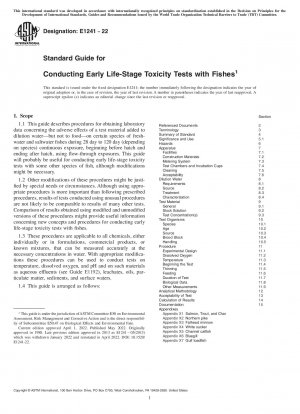ASTM E1241-22
Standard Guide for
- Standard No.
- ASTM E1241-22
- Release Date
- 2022
- Published By
- American Society for Testing and Materials (ASTM)
- Latest
- ASTM E1241-22
- Scope
- 1.1 This guide describes procedures for obtaining laboratory data concerning the adverse effects of a test material added to dilution water—but not to food—on certain species of freshwater and saltwater fishes during 28 day to 120 day (depending on species) continuous exposure, beginning before hatch and ending after hatch, using flow-through exposures. This guide will probably be useful for conducting early life-stage toxicity tests with some other species of fish, although modifications might be necessary. 1.2 Other modifications of these procedures might be justified by special needs or circumstances. Although using appropriate procedures is more important than following prescribed procedures, results of tests conducted using unusual procedures are not likely to be comparable to results of many other tests. Comparison of results obtained using modified and unmodified versions of these procedures might provide useful information concerning new concepts and procedures for conducting early life-stage toxicity tests with fishes. 1.3 These procedures are applicable to all chemicals, either individually or in formulations, commercial products, or known mixtures, that can be measured accurately at the necessary concentrations in water. With appropriate modifications these procedures can be used to conduct tests on temperature, dissolved oxygen, and pH and on such materials as aqueous effluents (see Guide E1192), leachates, oils, particulate matter, sediments, and surface waters. 1.4 This guide is arranged as follows: Section Referenced Documents 2 Terminology 3 Summary of Standard 4 Significance and Use 5.1 Hazards 6 Apparatus 7 Facilities 7.1 Construction Materials 7.2 Metering System 7.3 Test Chambers and Incubation Cups 7.4 Cleaning 7.5 Acceptability 7.6 Dilution Water 8 Requirements 8.1 Source 8.2 Treatment 8.3 Characterization 8.4 Test Material 9 General 9.1 Stock Solution 9.2 Test Concentration(s) 9.3 Test Organisms 10 Species 10.1 Age 10.2 Source 10.3 Brood Stock 10.4 Handling 10.5 Procedure 11 Experimental Design 11.1 Dissolved Oxygen 11.2 Temperature 11.3 Beginning the Test 11.4 Thinning 11.5 Feeding 11.6 Duration of Test 11.7 Biological Data 11.8 Other Measurements 11.9 Analytical Methodology 12 Acceptability of Test 13 Calculation of Results 14 Documentation 15 Appendixes Appendix X1 Salmon, Trout, and Char Appendix X2 Northern pike Appendix X3 Fathead minnow Appendix X4 White sucker Appendix X5 Channel catfish Appendix X6 Bluegill Appendix X7 Gulf toadfish 1 This guide is under the jurisdiction of ASTM Committee E50 on Environmental Assessment, Risk Management and Corrective Action and is the direct responsibility of Subcommittee E50.47 on Biological Effects and Environmental Fate. Current edition approved April 1, 2022. Published May 2022. Originally approved in 1988. Last previous edition approved in 2013 as E1241 – 05(2013) which was withdrawn January 2022 and reinstated in April 2022. DOI: 10.1520/ E1241-22. Copyright © ASTM International, 100 Barr Harbor Drive, PO Box C700, West Conshohocken, PA 19428-2959. United States This international standard was developed in accordance with internationally recognized principles on standardization established in the Decision on Principles for the Development of International Standards, Guides and Recommendations issued by the World Trade Organization Technical Barriers to Trade (TBT) Committee. 1 Appendix X8 Sheepshead minnow Appendix X9 Silversides Appendix X10 Statistical Guidance Appendix X11. Striped Bass 1.5 This standard does not purport to address all of the safety concerns, if any, associated with its use. It is the responsibility of the user of this standard to establish appropriate safety, health, and environmental practices and determine the applicability of regulatory limitations prior to use. Specific hazard statements are given in Section 6 and 9. 1.6 This international standard was developed in accordance with internationally recognized principles on standardization established in the Decision on Principles for the Development of International Standards, Guides and Recommendations issued by the World Trade Organization Technical Barriers to Trade (TBT) Committee.
ASTM E1241-22 Referenced Document
- ASTM D1129 Standard Terminology Relating to Water
- ASTM D1193 Standard Specification for Reagent Water
- ASTM D4447 Standard Guide for Disposal of Laboratory Chemicals and Samples
- ASTM E1022 Standard Guide for Conducting Bioconcentration Tests with Fishes and Saltwater Bivalve Mollusks
- ASTM E1023 Standard Guide for Assessing the Hazard of a Material to Aquatic Organisms and Their Uses
- ASTM E1192 Standard Guide for Conducting Acute Toxicity Tests on Aqueous Ambient Samples and Effluents with Fishes, Macroinvertebrates, and Amphibians
- ASTM E1203 Standard Practice for
Using Brine Shrimp Nauplii as Food for Test Animals in Aquatic Toxicology - ASTM E1733 Standard Guide for Use of Lighting in Laboratory Testing
- ASTM E1847 Standard Practice for Statistical Analysis of Toxicity Tests Conducted Under ASTM Guidelines
- ASTM E729 Standard Guide for Conducting Acute Toxicity Tests on Test Materials with Fishes, Macroinvertebrates, and Amphibians
- ASTM E943 Standard Terminology Relating to Biological Effects and Environmental Fate*, 2023-06-01 Update
ASTM E1241-22 history
- 2022 ASTM E1241-22 Standard Guide for
Conducting Early Life-Stage Toxicity Tests with Fishes - 2005 ASTM E1241-05(2013) Standard Guide for
Conducting Early Life-Stage Toxicity Tests with Fishes - 2005 ASTM E1241-05 Standard Guide for Conducting Early Life-Stage Toxicity Tests with Fishes
- 2004 ASTM E1241-98(2004) Standard Guide for Conducting Early Life-Stage Toxicity Tests with Fishes
- 1998 ASTM E1241-98 Standard Guide for Conducting Early Life-Stage Toxicity Tests with Fishes
